Yaudheya
Yaudheya or Yaudheya Gana (Yaudheya Republic) was an ancient militant confederation. The word Yaudheya is a derivative of the word yuddha or from yodha meaning warriors.[1][2] They principally were kshatriya renown for their skills in warfare, as inscribed in the Junagadh rock inscription of Rudradaman. The Yaudheyas emerged in the 5th century BCE. They not only survived the Maurya Empire and Shunga Empire, but also the Kshatraps and Kushan Empire.[1] The Yaudheya Republic flourished up to the middle to the 4th century when it was conquered by Samudragupta and incorporated into the Gupta Empire.[1]
Yaudheya | |
|---|---|
| 5th century BCE–4th century CE | |
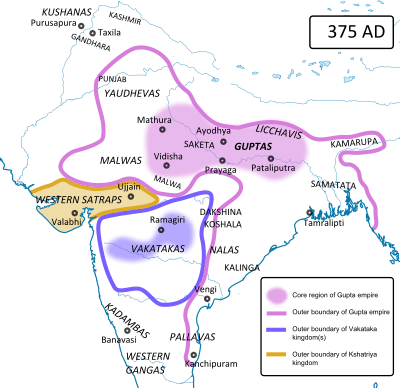 Yaudheya (in the north-west) and their contemporaries around 375 CE | |
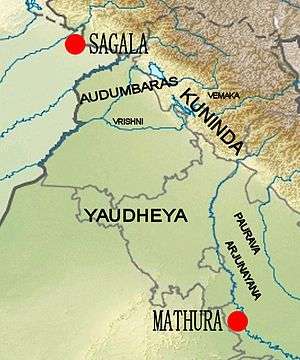 Location of the Yaudheya relative to other groups: the Audumbaras, the Vemakas, the Vrishnis, the Kunindas, the Pauravas and the Arjunayanas. | |
| Capital | Khokhrakot |
| Government | Republic |
| History | |
• Established | 5th century BCE |
• Disestablished | 4th century CE |
Geography
The Yaudheyas formed in the land between the Indus river and the Ganges river, called Bahudhanyaka, with their capital in Khokrakot (Rohtak). Bahudhanyaka was originally composed of modern-day Haryana. Early Yaudheya coins were additionally found in East Punjab, and North Rajasthan, and Western Uttar Pradesh. They also governed Garhwal, Kumaon, and Himachal Pradesh, in their later military campaigns.[3] Yaudheya coins have been excavated as far as Bahawalpur in Pakistan.
In the Mahabharata, the land Bahudhanyaka is stated to be among the countries subjugated by Nakula, the fourth Pandava in his conquest. Bahudhanyaka was the first to fall in Nakulas in of the western direction toward Sakastan, which agrees with the Rohtak-Hisar area.[4]
Varahamihira in his Brihatsamhita (XIV.28 and XVI.22) placed them in the northern division of India.
Literature
Puranas (e.g. Brahmanda, Vayu, Brahma and Harivamsha) described Yaudheyas as the descendants of Usinara and Nrigu.[5]
There are other references to them namely in the Mahabharata, Mahamayuri, Brihatsamhita, Puranas, Chandravyakarana and Kashika.
In the Mahabharata, the land Bahudhanyaka is stated to be among the countries subjugated by Nakula, the fourth Pandava. Bahudhanyaka was the first to fall to Nakulas conquest in of the western direction toward Sakastan, which agrees with the Rohtak-Hisar area.[4]
Varahamihira in his Brihatsamhita (XIV.28 and XVI.22) placed them in the northern division of India.
They are mentioned in Pāṇini's Ashtadhyayi and Ganapatha.
History
Rise of the Republic
.png)
The Yaudheyas emerged as an entity following the decline of the Kuru Kingdom (c. 1200 BCE–c. 525 BCE). The Yaudheyas would eventually encompass the land formerly belonging to the Kurus, including their former capitals Indraprastha, Hastinapur, and Āsandīvat. The Kuru Kingdom which was the prominent power in the Vedic age fell in importance when compared to the other Mahajanapadas.
The earliest references of the existence of the Yaudheyas is in Pāṇini's Ashtadhyayi (V.3.116-17 and IV.1.178) of (c.500 BCE) and the Ganapatha. In his works the Yaudheyas are mentioned as ayudha-jivin sanghas i.e., a community living by the profession of arms.[1]
The region of Bahudhanyaka was ruled by the Yaudheyas who minted coins bearing the legend 'Bahudhanyaka Yaudheyanam'.
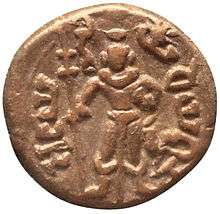
Maurya Empire
The Yaudheyas were incorporated into the Maurya Empire by Chandragupta Maurya. They also annexed the Pauravas. Chandragupta, under the tutelage of Chanakya, won over local kingdoms and republics in Punjab before conquering the Nanda Empire. Chandragupta heavily relied on the Yaudheya Gana in his campaigns.[6] His military had a high representation of the Yaudheya Gana and similar republicans. Additionally, Yaudheya elites and chiefs in were appointed government positions.
As recorded in the Bijoygarh inscription commissioned around Ashokas reign, the Yaudheya-gana-puraskrta appointed a chief who held the title of Maharaja-Senapati.[6] This chief of the Yaudheya republic was appointed the Mahasenapati or 'Great Commander of the Army' for the Mauryan military. The Arthashastra written by Chanakya described the senapati as adept in all modes of warfare (sarvayudha), all weapons (praharana), possessing modesty and restraint (vidyavinita), and capable of controlling all four wings of the army (chaturangini sena).
Post Maurya Empire
Soon after the death of Pushyamitra Shunga and Menander I, the Yaudheyas particularly asserted themselves independent. Yaudheyas mention military victories on their coins ("Victory of the Arjunayanas", "Victory of the Yaudheyas"). It is thought the Yaudheyas had become an independent kingdom at that point.[7]
In the second and first century BC the Yaudheyas occupied the Haryana (Bahudhanyaka) portion of Greater Punjab; comprising Rohtak, Hissar, Karnal and Gurugram, as well as the adjoining desert of Marwar.[8]
Defeat against the Western Satraps (2nd century CE)
During the second century CE when the Yaudheya gana revolted against the foreigners but they were soon checked by Rudradaman I.[8]
The Junagadh rock inscription of Rudradaman (c. 150 CE)[9] acknowledged the military might of the Yaudheyas "who would not submit because they were proud of their title "heroes among the Kshatriyas"", although the inscription claims that they were ultimately vanquished by Rudradaman.[10][11]
Rudradaman (...) who by force destroyed the Yaudheyas who were loath to submit, rendered proud as they were by having manifested their' title of' heroes among all Kshatriyas.
— Junagadh rock inscription[12]
Kushan Empire
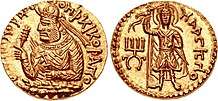
It is thought that the Kushans then became suzerains of the Yaudheyas when they endeavoured to hold the Mathura area.[13] An indication is the fact that the Kushan ruler Huvishka featured Maaseno on his coins, the Kushan incarnation of the Hindu god Karttikeya, or Skanda, whose epithet was "Mahasena". This god being particularly important to the Yaudheyas, it may have been incorporated into Kushan coinage when the Kushans expanded into Yaudheya territory.[14][13]
Feudatories of the Gupta Empire

The name of the Yaudheyas is later mentioned in the Allahabad pillar inscription of the Gupta Empire ruler Samudragupta, as submitting to his rule.[15]
(Lines 22–23) (Samudragupta, whose) formidable rule was propitiated with the payment of all tributes, execution of orders and visits (to his court) for obeisance by such frontier rulers as those of Samataṭa, Ḍavāka, Kāmarūpa, Nēpāla, and Kartṛipura, and, by the Mālavas, Ārjunāyanas, Yaudhēyas, Mādrakas, Ābhīras, Prārjunas, Sanakānīkas, Kākas, Kharaparikas and other (tribes)."
— Allahabad pillar of Samudragupta
Legacy
Alexander Cunningham hypothesized that the Johiya clan of Rajputs descended from Yaudheyas.[16]
Numismatic evidences
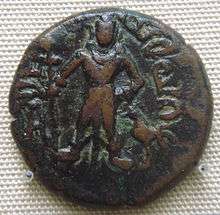
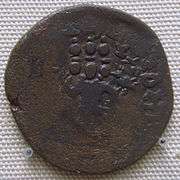 Six-headed Karttikeya on a Yaudheya coin. British Museum.
Six-headed Karttikeya on a Yaudheya coin. British Museum.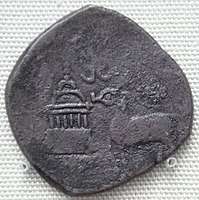 Karttikeya shrine with antelope. Yaudheya, Punjab, 2nd century CE
Karttikeya shrine with antelope. Yaudheya, Punjab, 2nd century CE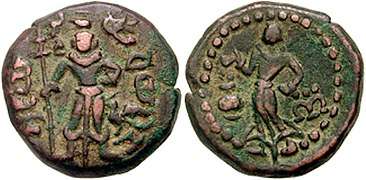 Coin of the Yaudheyas. Circa 3rd-4th Century CE.
Coin of the Yaudheyas. Circa 3rd-4th Century CE.
The Yaudheyas only utilized Brahmi script on their coins and seals.[17]
Alexander Cunningham divided the Yaudheya coins into two distinctive kinds; the older and smaller class A coins dating from before the 1st century BCE, and the larger Class B coins from the 3rd century CE during the decline of the Indo-Scythian power.[18] Cunningham states that the later coins evidently copied from the Indo-Scythians money.
John Allan classified Yaudheya coins into six classes, while Vincent Arthur Smith previously gave three types. The classification used by Allen has been mostly followed by scholars till today.
Yaudheya coins were found in the ancient capital of Khokrakot (modern Rohtak), and Naurangabad.
Based on the early coins produced by the Yaudheyas, it can be safely said that Karttikeya was considered their Iṣṭa-devatā.
Footnotes
- “Yaudheyas.” Ancient Communities of the Himalaya, by Dinesh Prasad. Saklani, Indus Pub. Co., 1998, pp. 112–115.
- Smith, V. (1897). Art. XXIX.—The Conquests of Samudra Gupta. Journal of the Royal Asiatic Society, 29(4), 859-910. doi:10.1017/S0035869X0002503X
- Saklani, Dinesh Prasad (1998). Ancient Communities of the Himalaya. Indus Publishing. ISBN 9788173870903.
- Bharadwaj, O. P. (1986). Studies in the Historical Geography of Ancient India. Sundeep Prakashan. ISBN 9788185055893.
- Pargiter, F.E. Ancient Indian Historical Tradition Motilal Banarasidass, Delhi, 1972 pp.109
- Gupta, Gyan Swarup (1999). India: From Indus Valley Civlization to Mauryas. Concept Publishing Company. ISBN 9788170227632.
- "Most of the people east of the Ravi already noticed as within Menander's empire -Audumbaras, Trigartas, Kunindas, Yaudheyas, Arjunayanas- began to coins in the first century BC, which means that they had become independent kingdoms or republics.", Tarn, The Greeks in Bactria and India p.324.
- Sharma, Suresh K. (2006-02-01). Haryana: Past and Present. Mittal Publications. ISBN 9788183240468.
- Junagadh Rock Inscription of Rudradaman I, accessed on 23 March 2007.
- Rosenfield, "The dynastic art of the Kushans", p132
- Rapson, "A catalogue of the Indian coins in the British Museum", p.lx
- Source
- Indian Sculpture: Circa 500 B.C.-A.D. 700, Los Angeles County Museum of Art, Pratapaditya Pal, University of California Press, 1986, p.78
- Classical Numismatics Group
- Corpus Inscriptionum Indicarum Vol 3 p251
- Cunningham, Sir Alexander (1882). Report of a Tour in the Punjab in 1878-79. Office of the Superintendent of Government Printing. p. 142.
yaudheyas.
- Bajpai, K. D. (October 2004). Indian Numismatic Studies. Abhinav Publications. ISBN 9788170170358.
- Cunningham, Sir Alexander (1882). Report of a Tour in the Punjab in 1878-79. Office of the Superintendent of Government Printing. p. 142.
yaudheyas.
Further reading
- Dasgupta, K.K. A Tribal History of Ancient India: A Numismatic Approach, Calcutta, 1974.
- Lahiri, Bela Indigenous States of Northern India (Circa 200 B.C. - 320 A.D.), University of Calcutta, 1974.